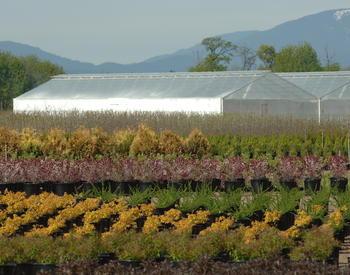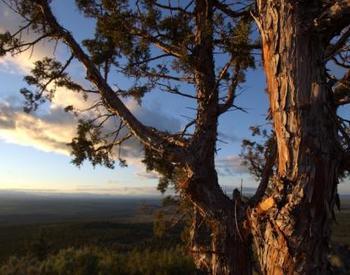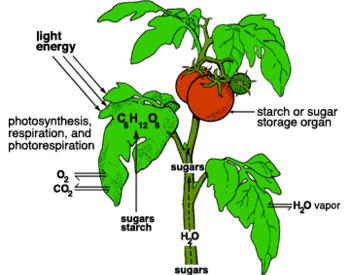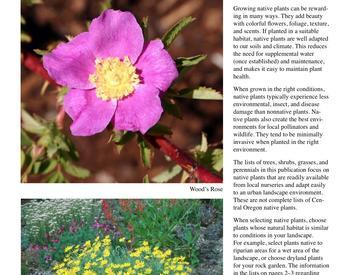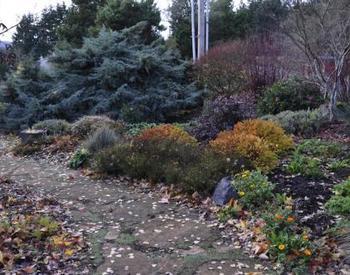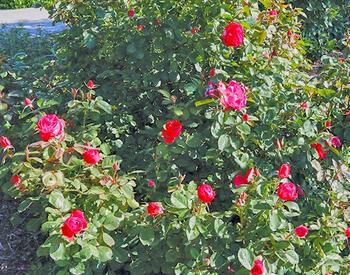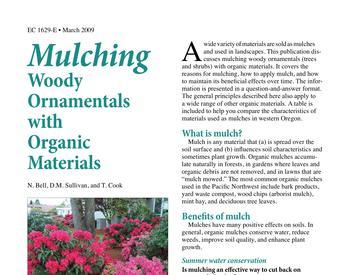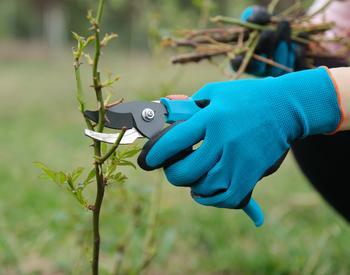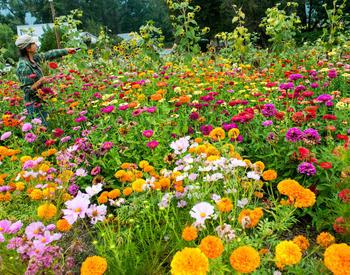AURORA, Ore. – In a sunbaked field in the northern Willamette Valley, 15 species of plants live or die on their own merit. Those that live could be the answer to one of horticulture’s biggest questions: What can we grow as climate change throws out all the rules?
In 2020, Lloyd Nackley, Oregon State University Extension Service nursery production and greenhouse management specialist, joined a multi-state research team of six Western universities to determine the climate readiness of selected ornamental plants.
“We are trying to find solutions for heat mitigation, including growing ornamentals under drought conditions to see which are the most ‘climate-ready’ to meet changing needs,” said Nackley, associate professor in the College of Agricultural Sciences. “Those that do best under low-water conditions will be recommended to the green industry. This hard data will guide nurseries in choosing appropriate plants to produce for western North America’s shifting climate.”
Finding climate-adapted plants is no small thing for the nursery industry, which topped the list of Oregon’s highest value agricultural commodity with sales of $1.32 billion in 2021, according to the Oregon Department of Agriculture. Keeping the industry robust is a major consideration of the Climate-Ready Landscape Plants Project, said Nackley, who leads a research lab that includes graduate students and field technicians.
The four-year, six-university research project straddles regions in the Western U.S. that don’t share the same climate, so each school focuses on plants that traditionally grow well in their areas. Initiated by the University of California, Davis, the program is the only one of its kind.
“There’s nothing like this outside of this study group,” Nackley said. “Our field trials are happening around the West, from Arizona to Washington. We’re the only ones using controlled irrigation over such a large latitude gradient.”
How the study works
Plants, which are planted in a randomized block design, undergo a full season of regular irrigation to minimize plant stress and allow rooting into the native soil to get fully established. Using the AgriMet weather station at the OSU North Willamette Research and Extension Center (NWREC) the researchers can adjust irrigation schedules according to the system’s measurements.
Evapotranspiration – how much water returns to the atmosphere as water leaves the soil – allows the researchers to adjust irrigation according to water levels. Like a cup emptying, heat draws water out of the soil and the levels are measured. The plants are arranged in three “hydrozones” where plants of similar water needs are grown together to receive the exact amount of water they require.
“As the soil dries and we hit a certain threshold, irrigation gets turned on,” Nackley said. “Each plant has a dripline going to it that can be adjusted at three levels of water. One is kept really wet, one medium and one we let dry down.”
Both summers of the study, Nackley invited nursery professionals, OSU Extension Master Gardeners and other stakeholders to help anonymously evaluate the plants. August is not the perfect month to spend in a hot field, but each year saw 30-50 stalwarts head to the field with pencil and pad in hand to look at 360 plants of 15 species and share their opinions and preferences. This valuable information gives Nackley additional reasons to say “yea” or “nay” to a plant.
“One of the biggest strengths of this project is engagement with people,” Nackley said. “We invite people to come and comment. It’s a form of crowdsourcing. We’re getting people who are familiar with plants; people who consider how plants grow and have good input.”
The plants, which are chosen by an advisory group of nursery growers and landscape designers, were evaluated on growth, visual appeal, timing of flowering, density of flowers, physiology and heat tolerance. Most, like mock orange, rose of Sharon, rosemary and Oregon grape, are commonly grown by Oregon nurseries and planted in gardens by homeowners. A few – vitex and western spice bush – are lesser known and others are so new that they haven’t been released.
“Nackley was impressed with two roses, Proven Winners ColorChoice 'Oso Easy Urban Legend' and Star Roses 'Petite Knockout.'”
“They are incredibly drought-tolerant,” he said. “But not just that. They deadhead themselves. They are low maintenance. Set it and forget it.”
Others that stood out were the ninebarks Physocarpus ‘Little Devil’ and ‘Diablo,’ which bloomed all summer, and both eastern and western redbuds did well. Rose of Sharon came through unscathed. There were losers, too. Lantana was a goner because cold winter temperatures and Hydrangea paniculata ‘Strawberry Shake,’ typically a sun-tolerant plant, was crisped by the summer drought.
Performance and appearance
Each plant’s performance was meticulously assessed and assigned a Mean Overall Appearance Score on a scale from 1-5, with 5 indicating excellent performance. If a plant scored 3 or less, it wasn’t recommended for use under their specific irrigation conditions.
Blue Ribbon Winners excelled in stringent watering conditions, receiving only 20% of their potential water needs. Happy Mediums maintained excellent aesthetics with 40%-60% of the required irrigation. During open house events, participants voted for People’s Choice and the team choose their personal favorites.
In the NWREC trial several plants were designated Blue Ribbon Winners, including Ceanothus ‘Victoria,’ Hibiscus ‘Purple Pillar,’ ‘Urban Legend and ‘Petite Knock Out’ roses, ‘Arp’ rosemary and Vitex ‘Blue Diddley.’ Notably, there were no Happy Mediums because many of the drought-tolerant species fared poorly due to the hot, dry Oregon summers.
Nackley’s research data of Oregon’s Willamette Valley and the results of other five participating universities in their climates will be shared with the UC Davis, enriching their database with 15 years of insights from the Davis location.
“More than anything, our project creates conversation about how to have a beautiful garden without so much water,” Nackley said. “There’s a lot of doom and gloom about whether a lot of plants will do well. We want to tell people about the changing water availability but also about beautiful plants that will do well.”
To keep up with the research, check the Nackley Lab blog. The project, which was funded by the U.S. Department of Agriculture, will continue into 2025.
